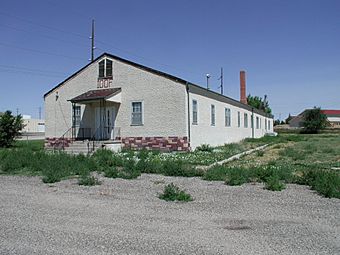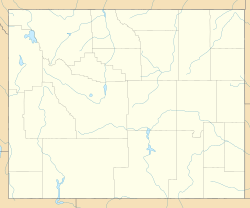Camp Douglas (Wyoming) facts for kids
Quick facts for kids |
|
|
Officer's Club, Douglas Prisoner of War
|
|

Officer's Club from 1943
|
|
| Location | 115 S. Riverbend Dr., Douglas, Wyoming |
|---|---|
| Area | 1.5 acres (0.61 ha) |
| Built | 1943 |
| NRHP reference No. | 01000965 |
| Added to NRHP | September 8, 2001 |
Camp Douglas was a special camp for Prisoners of War (POWs) during World War II. It was located in Douglas, Wyoming, in the United States. From January 1943 to February 1946, the camp held Italian and then German soldiers.
Not many buildings from the camp are left today. But the walls of the Officer's Club have amazing murals. Three Italian prisoners painted these pictures. They show scenes of western life and old stories. These paintings are now officially recognized by the United States Department of the Interior National Park Service. They are listed on the National Register of Historic Places. The story of this POW camp is a really important part of Douglas's history.
Contents
The Officer's Club: A Special Building
The Officer's Club at the old Douglas POW Camp was built in 1943. It's a long, rectangular building, about 37 feet wide and 132 feet long. It was made from wood and sat on a concrete base.
In the 1980s, stucco was added to the outside walls. The roof is covered with asphalt shingles. There's also an enclosed porch on one side. A tall brick chimney stands on the roof.
Inside, the north end has a kitchen and furnace room. Further south, there are two bathrooms and a small game room. Most of the building is a large club room. From here, you can go to the enclosed porch. The very south end has storage rooms.
The building has many windows, some single and some paired. The porch also has many windows, but most are now covered. Inside, many walls are covered with a material called celotex. The club room and game room have half-paneled walls. The floors are mostly wood, but some areas have linoleum or carpet.
Amazing Murals Inside
The club room holds a true treasure: sixteen murals painted by three Italian prisoners. They created these artworks between 1943 and 1944. These charming paintings show famous parts of the American West. You can see cowboys, Native Americans, wagon trains, and cattle drives. There's even a fort and the famous Old Faithful geyser from Yellowstone National Park.
These murals are special because they show the West through the eyes of Italians. They likely only saw these scenes in American movies and books. It's their unique vision of a faraway land.
Keeping History Alive
Recently, people in Douglas have worked to save this unique building. They want to protect the murals. Experts have studied the paintings to plan how to keep them safe. The goal is to open the building to the public one day. Then, more people can see these amazing murals. Many people in Wyoming don't even know they exist!
The Officer's Club is important because it shows how World War II affected communities. Even though battles didn't happen in the U.S., the war changed things at home. The Douglas POW Camp shows America's strength during the war. It highlights how quickly the country built military places. The building also shows new ways of building things fast, like using standard plans and assembly-line methods.
Murals: Art from POWs
The murals painted by the three Italian POWs are very special. They show scenes of the American West. It's amazing that these men painted what they imagined the West to be like. They probably only saw it in movies and books.
Other military places had murals during World War II. But many of those buildings were torn down. So, few murals from that time still exist. These murals might be the only ones painted by Italian POWs. Most others were done by German prisoners.
The Officer's Club was one of 180 buildings built at the camp. It took only 95 days to build the whole camp in 1943! The camp cost about $1.1 million. Douglas was one of 155 main and smaller camps across the U.S. that held POWs from Europe and Japan.
Camp Douglas: A Look Back
In 1942, only about 2,000 prisoners came to the U.S. But soon, there were too many POWs overseas. So, the U.S. military started a program to house them here. They used old camps, parts of military bases, and even fairgrounds. They also built new "tent cities."
A bigger plan for POW camps began in late 1942. These camps needed to be in quiet, faraway places. They couldn't be too close to the coasts or borders. They also avoided places near factories or important war industries. This was to prevent any sabotage. The best spot was a flat, well-drained area near a railroad.
Building these camps also followed the Geneva Conventions. These were international agreements signed in 1929. They set rules for how enemy prisoners should be treated. The U.S. tried hard to follow these rules. Camps had to meet basic military standards.
Why Douglas Was Chosen
Having a large POW camp was good for a state's economy. So, many towns wanted one. Business leaders and politicians in Wyoming worked to get military bases built. Douglas was chosen for a POW camp.
The Douglas site was perfect. It was in Converse County, near a railroad. The land was also above the North Platte River. The government bought the land. Construction started in February 1943. Workers used the state fairgrounds buildings as dorms. The company finished building the camp in just 95 days!
Camp Layout
The Officer's Club and softball field were near the main entrance. This was outside the fences. The rest of the camp had double wire fences, some even electrified. Guard towers watched over everything. Inside, there was a hospital and barracks for troops. The prison area had three sections. Each could hold about 1,000 men. Prisoners also had outdoor recreation areas, including a softball and football field. The camp also had buildings for vehicles, a heating plant, and even a K-9 dog unit.
The mayor of Douglas asked people to rent rooms to military families. The town also set up a Service Men's Center. It was a popular place for soldiers to relax. The local newspaper was excited about the camp. It focused on the arrival of the U. S. Army and the officers. It didn't mention any worries about having enemy prisoners nearby.
POWs were also a solution to a big problem. Many Wyoming men went to war. This left a shortage of farm workers. POWs helped with important jobs like harvesting crops. Farmers in Converse County even formed a group to hire the prisoners.
Camp Opening and Italian POWs
The first Army staff arrived at the camp in May 1942. On June 20, the camp opened for civilians to visit. Over 2,000 people came to see it. They were very impressed by the 150-bed hospital.
The first Italian POWs arrived in August 1942 from New York City. About 412 prisoners from the Tunisian Campaign came by train. They marched to the camp. All new POWs were checked at the hospital. They got new clothes and were assigned to a section. By the end of the year, there were 1,900 Italian POWs. This included officers who supervised the other prisoners.
The Italian prisoners played soccer and did calisthenics outside. One Italian prisoner learned American cooking. He cooked for his fellow prisoners and camp staff. A Catholic chaplain gave some prisoners musical instruments. They even set up a small church in the camp theater. They put on musical shows and plays using costumes made from flour sacks.
The three Italian prisoners who painted the murals were V. Finotti, E. Tarquinio, and F. DeRossi. Their large murals are six to fifteen feet long. They show cowboys, bar shootouts, and Native Americans. There's also a wagon train and a frontier fort. It's funny that they painted Yellowstone National Park's Old Faithful geyser. As prisoners, they couldn't explore the real West. Their ideas came from movies and books.
German POWs Arrive
When Italy surrendered in 1944, the Italian prisoners left. The camp was empty for a short time. But it quickly reopened for German prisoners. By October 1944, over 2,000 German prisoners were there. The number reached its highest point the next summer, with 3,011 Germans.
The German prisoners were a mixed group. Their ages ranged from 14 to 80. Most were cooperative. But some strong Nazis caused trouble. They tried to cut fences and bothered other prisoners. The camp stopped their newsletter because it was full of Nazi propaganda. A less political paper took its place.
Prisoners spent time in the camp library. They also played sports. Some put on plays and concerts for other prisoners and the public. Some prisoners were skilled artisans. They drew portraits and made things like shelves. They used dried cottage cheese as glue! Many of these items were given to people in Douglas. You can see them at the Douglas Pioneer Museum.
Like the Italians, German POWs also worked in agriculture. They earned $4.00 a day. Half of their pay was given in camp money for the store. The other half was saved until they went home. Some prisoners saved over $500!
POWs worked in the area around Douglas. They also went to other towns to help with harvests. Guards always went with the prisoners. But security was sometimes relaxed away from the camp.
Escape Attempts
There were a few small escape attempts at the camp. Guards found two prisoners hiding in a haystack. They were wearing many layers of winter underwear! Three Germans used paper dummies to trick guards during roll call. Another group escaped about 25 miles south. They hid for a week. They were caught when they asked what state they were in.
Camp Closing
By August 1945, the war was ending. The camp commander announced that POW labor would stop. Prisoners would soon go home. The Douglas camp slowly released prisoners starting in November 1945. It officially closed on February 1, 1946.
Many prisoners and Douglas residents had become friends. They kept in touch for years after the war. Some even visited each other's countries.
After the camp closed, the land and buildings were sold. Converse County bought the camp hospital. The Community Country Club bought the Officers Club. The local school district bought 15 buildings and land for a farm. Other buildings were taken apart and sold for lumber.
By the 1980s, the old camp site looked very different. Interstate 25 cut through it. Businesses, homes, and schools covered much of the land. Only a few people wanted to keep the camp's history alive.
The Douglas Lodge #15, Independent Order of Odd Fellows, was one of these groups. They bought the Officers Club in 1963. They have worked hard to keep the building and protect the unique murals.
In 2015, the Officers' Club became a Wyoming State Historic Site. It is now cared for by Wyoming State Parks. The club is open to the public during the summer months.
Listing the Officer's Club on the National Register of Historic Places honors those who saved it. It also remembers the thousands of people who lived at the camp during the war.
Images for kids













